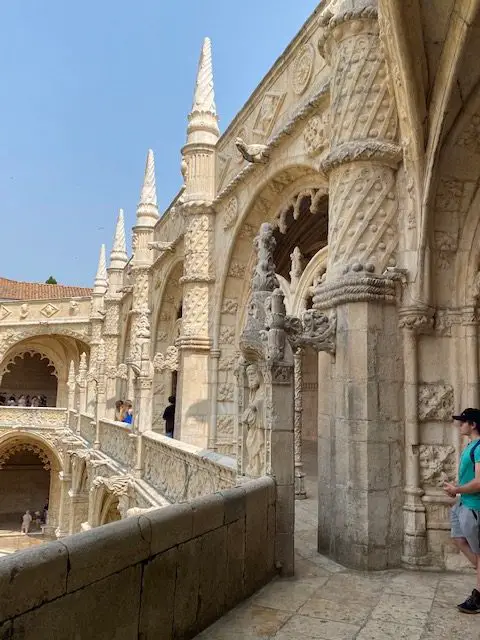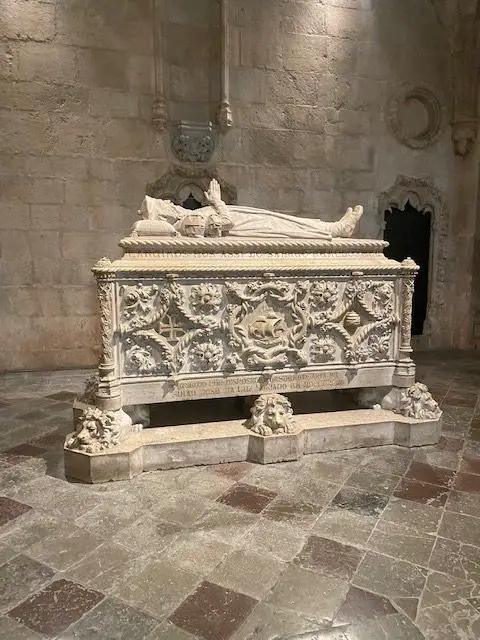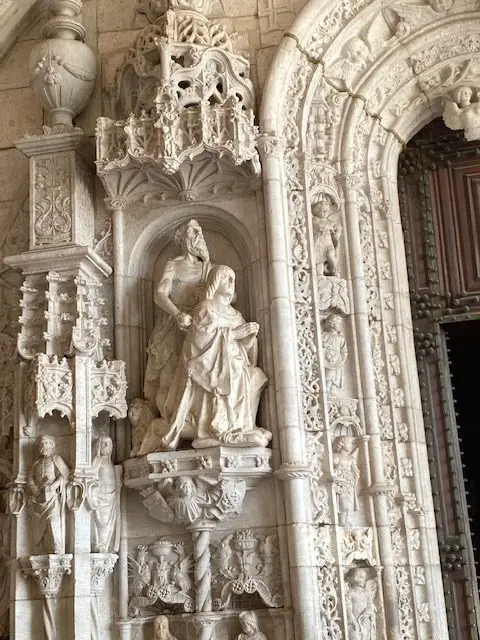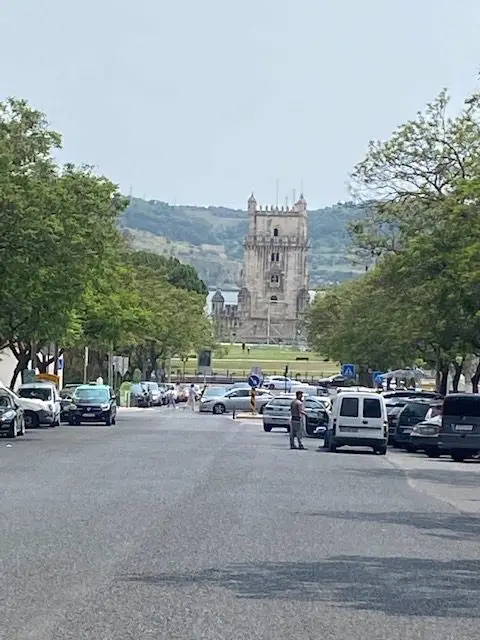Is the Jerónimos Monastery or Mosteiro dos Jerónimos worth visiting?
If you want to experience the power and wealth that Portugal had during the Portuguese Age of Exploration, yes.
If you are interested in seeing the tomb of one of the world’s greatest adventurers, yes.
If you enjoy intricate and beautiful 16th-century sculpture and carving, yes.
If you appreciate UNESCO world heritage sites, yes.

Not only is the Jeronimo’s Monastery is a must-see attraction in Portugal, but it is one of the top stops on my Lisbon 24 hour checklist – what should I see and do? if you are only going to be in town for a short while.
And as an added bonus, there is another UNESCO heritage site just down the street.
Between the Monastery, the Torre de Belém, and the Monument to the Discoveries, as well as some great food options nearby, you could easily spend half or most of a day on this street.
For more information on what the Belém neighborhood has to offer, see my article, Lisbon’s historic Belém neighborhood | Everything you need to know
In fact, I would aim to visit mid or late afternoon and turn it into an opportunity to catch a beautiful sunset behind the Belém Tower.

Going later in the day will also help you avoid long lines. In the summer, I recommend that you wear sunscreen, and have a hat or a parasol, because you will be in line for a while – but it is worth the wait!
Mosteiro dos Jerónimos Hours and Tickets
Hours: October to April open from 10 am – 5 pm, May – September 10 am – 6:30 pm, On Sundays from May – September the monastery closes at 6 pm.
Admission: €10. Children 12 and under are free. Ages 65 and older pay €5.
Official website:

How to get to the Jerónimos Monastery
Address: Praça do Império 1400
GPS: 38.698062533207484, -9.206725359913055
T: 351 213 620 034E: geral@mjeronimos.pt
Taxi or Uber takes roughly 20 minutes and €10 from downtown.
You could opt for bus 714 or 728, or you could take the train toward Cascais from Cais do Sodré train station, which takes about 10 minutes. Get off in Belém and walk west along the river.
Another option is the 15E tram, which takes 30 to 40 minutes. You can catch it at Praça da Figueira or Praça do Comércio.
Is it worth visiting the Jerónimos Monastery? Why is the Jerónimos Monastery important?
Inside the church, you will find a memorial to Luís de Camões, one of Portugal’s favorite poets and adventurers. Camões lived from 1524 until 1580.
He wrote Os Lusiadas, an epic poem that describes Vasco da Gama‘s first voyage to India.
Camōes is the writer who first described Portugal as the place where “sea ends and land begins.”
In addition to being Portugal’s greatest poet, Camões also went to Morocco to fight the Moors and lost an eye in the battle.
The warrior-poet was also imprisoned in Goa, and shipwrecked in China. No one knows where his body is.

Another Lisbon writer, Fernando Pessoa (1888-1935), is one of the biggest figures of 20th-century literature. He wrote in Portuguese, French, and English.
He also worked as a translator. Pessoa had a strong interest in astrology and the occult.
Under one of his 75 pen names, he wrote horoscopes for both common people and world leaders.
Interestingly, these were more than pen names, as Pessoa created characters and biographies for them, and would have these different authors debate and criticize one another.
Pessoa also is said to have lived at more than 25 locations in Lisbon. His final resting place is in the church at the Jerónimos Monastery.
Exploring giant Vasco da Gama is also buried in the Mosteiro dos Jerónimos. On July 7, 1497, Vasco da Gama (1460 – 1524) and his men prayed in the chapel at this location before setting out for their two-year journey. With 150 men and four ships, he went to find a sea route to Asia.

A pivotal event in world history, they returned to Lisbon successfully in 1499, loaded down with spices, and tails of India.
Prior to this, spices came to Europe overland and eventually ran through Venice.
The Venetians controlled the import of goods to Europe.
But with Vasco da Gama’s discovery, Portugal was able to eliminate Venice as the shipping middleman.
As the sales of the spices were taxed, wealth poured into Portugal, and in 1501 King Manuel decided to build this monastery on the spot where Vasco da Gama prayed and said goodbye to their families. The monastery is one of the oldest buildings that you can still see in Lisbon.
King Manuel is also buried within. Manuel reigned from 1495 until 1521. He is known as Manuel the Fortunate because he reaped the benefits of Portuguese exploration.
He was king at a time when Portugal was one of the world’s superpowers.
With this prosperity, Manuel built many great buildings, several of which were destroyed in the 1755 earthquake.
Among his building projects which remain are the Jerónimos Monastery, the Tower of Belém, the Batalha Monastery, the Pena Palace in Sintra, and parts of the Convento de Cristo in Tomar.
These are the only remaining examples of the Manueline architecture style.

Commissioned by King Manuel during a short period of time, they all feature stunning detail and nautical themes – ropes, ships, sea plants, and various animals both real and mythical.
The columns are tall and thin, like palm trees, and the arches and vaulted ceilings are rounded.
The intricate details and beauty of this building will impress you.
UNESCO made the Jerónimos Monastery and the nearby Tower of Belém a world heritage site in 1983.
The monastery has also featured in modern history when in 1985 it held a ceremony to welcome Portugal into the European Economic Community.
The monastery was also the site of the signing of the treaty of Lisbon in 2007, which reformed the European Union.
Guided tours of the Jerónimos Monastery
I’d like to pretend that I can describe all of the details and their significance, but I cannot. Perhaps a local guide who has spent a lot of time in the monastery would be a good call.
You can find more information on guided tours here http://www.patrimoniocultural.gov.pt/pt/museus-e-monumentos/dgpc/m/mosteiro-dos-jeronimos/
This walking tour of the Belém neighborhood is led by a professional art historian.
You will discuss the Pastéis de Belém bakery, see the Monument to the Discoveries, and learn about the Belém tower. Admission to the Jerónimos Monastery is included in the $84 cost of the tour, and you also get to skip the long line.
Other ways to skip the Line at the Jerónimos Monastery
You can purchase a skip-the-line ticket through Get Your Guide at
The long, west wing of the monastery was formerly the monks’ dormitory.
Today it houses the National Museum of Archaeology of Portugal. Entering here instead, you can purchase a combination ticket to the archaeology museum, the monastery, and the Belém Tower for €12. This entrance will save you an immense amount of time standing in line.
What else is near the Jerónimos Monastery?
The Monument to the Discoveries is located across from the Jerónimos Monastery, on the Tejo River. The modern monument to the Portuguese Age of Exploration is known as Padrão aos Descobrimentos in Portuguese. To learn more, see my Lisbon’s Monument to the Discoveries | Everything you need to know
The famous Belém Tower (known as the Torre de Belém or Torre de São Vicente), is an icon of Lisbon, a UNESCO World Heritage Site, that roughly 100 meters west of the Monument to the Discoveries. The Belém Tower has a nice park and is a great spot for a picnic. You can read my Surprising Belém Tower facts

The new QUAKE – Lisbon Earthquake Experience is an interactive museum that focuses on the history and science of Lisbon’s 1755 earthquake. lt is located next-door to Portugal’s most popular museum – the National Coach Museum – a huge collection of royal stagecoaches, carriages, and berlins.
Both 0f these museums appeal to children, as does the nearby Museum of Art, Architecture, and Technology.
If history is more your thing, the Ajuda National Palace is near-by, as well as the recently opened Royal Treasure Museum that houses the crown jewels of Portugal.
Also, you will pass by the LX Factory (under the 25 de Abril Bridge) on your way to the Jerónimos Monastery.
Also nearby, you can find fantastic art installations by some of Lisbon’s biggest artists (Read my Where to see street art in Lisbon), and you can enjoy the original Pastel de Belém. For more information, see my article The big difference between Pastéis de Belém and Pastéis de Nata – lisbontravelideas.com
If you purchase something from a link on this page, I may earn a small commission. Thank you for supporting my work, and thank you for reading about the Jerónimos Monastery.